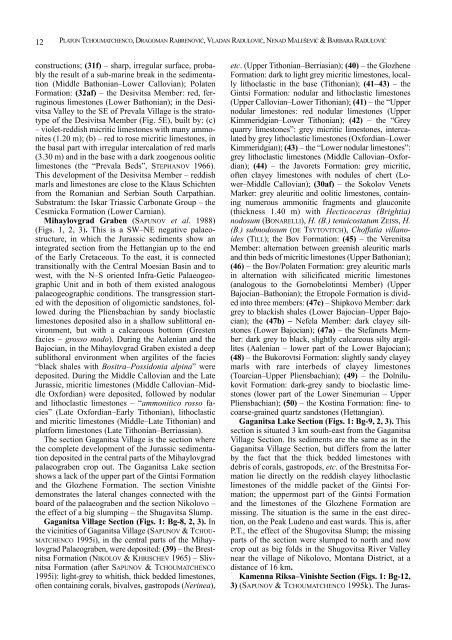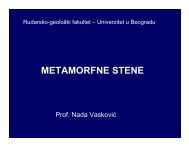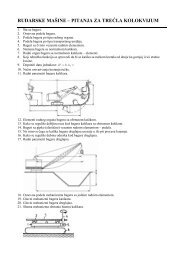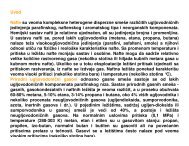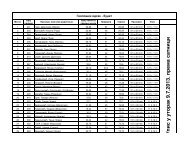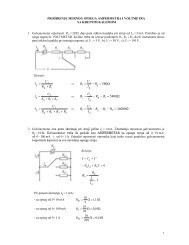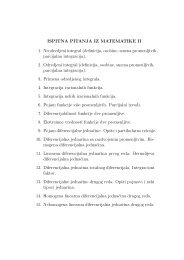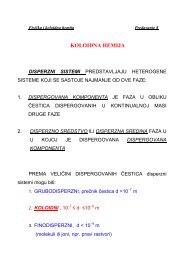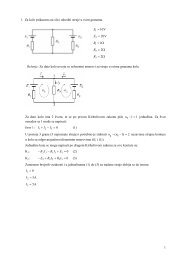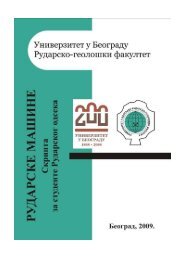KÑига LXXII
KÑига LXXII
KÑига LXXII
You also want an ePaper? Increase the reach of your titles
YUMPU automatically turns print PDFs into web optimized ePapers that Google loves.
12<br />
PLATON TCHOUMATCHENCO, DRAGOMAN RABRENOVIĆ, VLADAN RADULOVIĆ, NENAD MALEŠEVIĆ & BARBARA RADULOVIĆ<br />
constructions; (31f) – sharp, irregular surface, probably<br />
the result of a sub-marine break in the sedimentation<br />
(Middle Bathonian–Lower Callovian); Polaten<br />
Formation: (32af) – the Desivitsa Member: red, ferruginous<br />
limestones (Lower Bathonian); in the Desivitsa<br />
Valley to the SE of Prevala Village is the stratotype<br />
of the Desivitsa Member (Fig. 5E), built by: (c)<br />
– violet-reddish micritic limestones with many ammonites<br />
(1.20 m); (b) – red to rose micritic limestones, in<br />
the basal part with irregular intercalation of red marls<br />
(3.30 m) and in the base with a dark zoogenous oolitic<br />
limestones (the “Prevala Beds”, STEPHANOV 1966).<br />
This development of the Desivitsa Member – reddish<br />
marls and limestones are close to the Klaus Schichten<br />
from the Romanian and Serbian South Carpathian.<br />
Substratum: the Iskar Triassic Carbonate Group – the<br />
Cesmicka Formation (Lower Carnian).<br />
Mihaylovgrad Graben (SAPUNOV et al. 1988)<br />
(Figs. 1, 2, 3). This is a SW–NE negative palaeostructure,<br />
in which the Jurassic sediments show an<br />
integrated section from the Hettangian up to the end<br />
of the Early Cretaceous. To the east, it is connected<br />
transitionally with the Central Moesian Basin and to<br />
west, with the N–S oriented Infra-Getic Palaeogeographic<br />
Unit and in both of them existed analogous<br />
palaeogeographic conditions. The transgression started<br />
with the deposition of oligomictic sandstones, followed<br />
during the Pliensbachian by sandy bioclastic<br />
limestones deposited also in a shallow sublittoral environment,<br />
but with a calcareous bottom (Gresten<br />
facies – grosso modo). During the Aalenian and the<br />
Bajocian, in the Mihaylovgrad Graben existed a deep<br />
sublithoral environment when argilites of the facies<br />
“black shales with Bositra–Possidonia alpina” were<br />
deposited. During the Middle Callovian and the Late<br />
Jurassic, micritic limestones (Middle Callovian–Middle<br />
Oxfordian) were deposited, followed by nodular<br />
and lithoclastic limestones – “ammonitico rosso facies”<br />
(Late Oxfordian–Early Tithonian), lithoclastic<br />
and micritic limestones (Middle–Late Tithonian) and<br />
platform limestones (Late Tithonian–Berriassian).<br />
The section Gaganitsa Village is the section where<br />
the complete development of the Jurassic sedimentation<br />
deposited in the central parts of the Mihaylovgrad<br />
palaeograben crop out. The Gaganitsa Lake section<br />
shows a lack of the upper part of the Gintsi Formation<br />
and the Glozhene Formation. The section Vinishte<br />
demonstrates the lateral changes connected with the<br />
board of the palaeograben and the section Nikolovo –<br />
the effect of a big slumping – the Shugavitsa Slump.<br />
Gaganitsa Village Section (Figs. 1: Bg-8, 2, 3). In<br />
the vicinities of Gaganitsa Village (SAPUNOV & TCHOU-<br />
MATCHENCO 1995i), in the central parts of the Mihaylovgrad<br />
Palaeograben, were deposited: (39) – the Brestnitsa<br />
Formation (NIKOLOV & KHRISCHEV 1965) – Slivnitsa<br />
Formation (after SAPUNOV & TCHOUMATCHENCO<br />
1995i): light-grey to whitish, thick bedded limestones,<br />
often containing corals, bivalves, gastropods (Nerinea),<br />
etc. (Upper Tithonian–Berriasian); (40) – the Glozhene<br />
Formation: dark to light grey micritic limestones, locally<br />
lithoclastic in the base (Tithonian); (41–43) – the<br />
Gintsi Formation: nodular and lithoclastic limestones<br />
(Upper Callovian–Lower Tithonian); (41) – the “Upper<br />
nodular limestones: red nodular limestones (Upper<br />
Kimmeridgian–Lower Tithonian); (42) – the “Grey<br />
quarry limestones”: grey micritic limestones, intercalated<br />
by grey lithoclastic limestones (Oxfordian–Lower<br />
Kimmeridgian); (43) – the “Lower nodular limestones”:<br />
grey lithoclastic limestones (Middle Callovian–Oxfordian);<br />
(44) – the Javorets Formation: grey micritic,<br />
often clayey limestones with nodules of chert (Lower–Middle<br />
Callovian); (30af) – the Sokolov Venets<br />
Marker: grey aleuritic and oolitic limestones, containing<br />
numerous ammonitic fragments and glauconite<br />
(thickness 1.40 m) with Hecticoceras (Brightia)<br />
nodosum (BONARELLI), H. (B.) tenuicostatum ZEISS, H.<br />
(B.) subnodosum (DE TSYTOVITCH), Choffatia villanoides<br />
(TILL); the Bov Formation: (45) – the Verenitsa<br />
Member: alternation between greenish aleuritic marls<br />
and thin beds of micritic limestones (Upper Bathonian);<br />
(46) – the Bov/Polaten Formation: grey aleuritic marls<br />
in alternation with silicificated micritic limestones<br />
(analogous to the Gornobelotintsi Member) (Upper<br />
Bajocian–Bathonian); the Etropole Formation is divided<br />
into three members: (47c) – Shipkovo Member: dark<br />
grey to blackish shales (Lower Bajocian–Upper Bajocian);<br />
the (47b) – Nefela Member: dark clayey siltstones<br />
(Lower Bajocian); (47a) – the Stefanets Member:<br />
dark grey to black, slightly calcareous silty argillites<br />
(Aalenian – lower part of the Lower Bajocian);<br />
(48) – the Bukorovtsi Formation: slightly sandy clayey<br />
marls with rare interbeds of clayey limestones<br />
(Toarcian–Upper Pliensbachian); (49) – the Dolnilukovit<br />
Formation: dark-grey sandy to bioclastic limestones<br />
(lower part of the Lower Sinemurian – Upper<br />
Pliensbachian); (50) – the Kostina Formation: fine- to<br />
coarse-grained quartz sandstones (Hettangian).<br />
Gaganitsa Lake Section (Figs. 1: Bg-9, 2, 3). This<br />
section is situated 3 km south-east from the Gaganitsa<br />
Village Section. Its sediments are the same as in the<br />
Gaganitsa Village Section, but differs from the latter<br />
by the fact that the thick bedded limestones with<br />
debris of corals, gastropods, etc. of the Brestnitsa Formation<br />
lie directly on the reddish clayey lithoclastic<br />
limestones of the middle packet of the Gintsi Formation;<br />
the uppermost part of the Gintsi Formation<br />
and the limestones of the Glozhene Formation are<br />
missing. The situation is the same in the east direction,<br />
on the Peak Ludeno and east wards. This is, after<br />
P.T., the effect of the Shugovitsa Slump; the missing<br />
parts of the section were slumped to north and now<br />
crop out as big folds in the Shugovitsa River Valley<br />
near the village of Nikolovo, Montana District, at a<br />
distance of 16 km.<br />
Kamenna Riksa–Vinishte Section (Figs. 1: Bg-12,<br />
3) (SAPUNOV & TCHOUMATCHENCO 1995k). The Juras-


